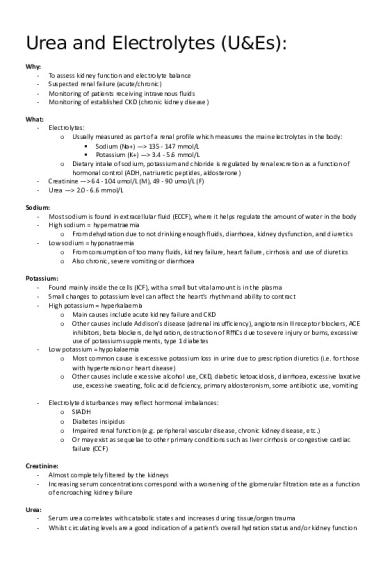U&Es - Summary of urea and electrolytes test and results PDF

| Title | U&Es - Summary of urea and electrolytes test and results |
|---|---|
| Author | Imogen Wright |
| Course | Medical investigations |
| Institution | University of Bristol |
| Pages | 1 |
| File Size | 58.1 KB |
| File Type | |
| Total Downloads | 10 |
| Total Views | 139 |
Summary
Summary of urea and electrolytes test and results...
Description
Urea and Electrolytes (U&Es): Why: -
To assess kidney function and electrolyte balance Suspected renal failure (acute/chronic) Monitoring of patients receiving intravenous fluids Monitoring of established CKD (chronic kidney disease)
What: - Electrolytes: o Usually measured as part of a renal profile which measures the main electrolytes in the body: Sodium (Na+) —> 135 - 147 mmol/L Potassium (K+) —> 3.4 - 5.6 mmol/L o Dietary intake of sodium, potassium and chloride is regulated by renal excretion as a function of hormonal control (ADH, natriuretic peptides, aldosterone) - Creatinine —> 64 - 104 umol/L (M), 49 - 90 umol/L (F) - Urea —> 2.0 - 6.6 mmol/L Sodium: - Most sodium is found in extracellular fluid (ECCF), where it helps regulate the amount of water in the body - High sodium = hypernatraemia o From dehydration due to not drinking enough fluids, diarrhoea, kidney dysfunction, and diuretics - Low sodium = hyponatraemia o From consumption of too many fluids, kidney failure, heart failure, cirrhosis and use of diuretics o Also chronic, severe vomiting or diarrhoea Potassium: - Found mainly inside the cells (ICF), with a small but vital amount is in the plasma - Small changes to potassium level can affect the heart’s rhythm and ability to contract - High potassium = hyperkalaemia o Main causes include acute kidney failure and CKD o Other causes include Addison’s disease (adrenal insufficiency), angiotensin II receptor blockers, ACE inhibitors, beta blockers, dehydration, destruction of RBCs due to severe injury or burns, excessive use of potassium supplements, type 1 diabetes - Low potassium = hypokalaemia o Most common cause is excessive potassium loss in urine due to prescription diuretics (i.e. for those with hypertension or heart disease) o Other causes include excessive alcohol use, CKD, diabetic ketoacidosis, diarrhoea, excessive laxative use, excessive sweating, folic acid deficiency, primary aldosteronism, some antibiotic use, vomiting -
Electrolyte disturbances may reflect hormonal imbalances: o SIADH o Diabetes insipidus o Impaired renal function (e.g. peripheral vascular disease, chronic kidney disease, etc.) o Or may exist as sequelae to other primary conditions such as liver cirrhosis or congestive cardiac failure (CCF)
Creatinine: - Almost completely filtered by the kidneys - Increasing serum concentrations correspond with a worsening of the glomerular filtration rate as a function of encroaching kidney failure Urea: - Serum urea correlates with catabolic states and increases during tissue/organ trauma - Whilst circulating levels are a good indication of a patient’s overall hydration status and/or kidney function...
Similar Free PDFs

Fluid and Electrolytes
- 23 Pages

Fluid and Electrolytes ( Hurst)
- 4 Pages

Fluids and Electrolytes (Autosaved)
- 22 Pages

Adaptive quiz fluid and electrolytes
- 20 Pages

Malachite Data and Results
- 2 Pages

Fluids and Electrolytes Outline A
- 17 Pages

UREA - urea ensayo
- 8 Pages

Urea
- 10 Pages
Popular Institutions
- Tinajero National High School - Annex
- Politeknik Caltex Riau
- Yokohama City University
- SGT University
- University of Al-Qadisiyah
- Divine Word College of Vigan
- Techniek College Rotterdam
- Universidade de Santiago
- Universiti Teknologi MARA Cawangan Johor Kampus Pasir Gudang
- Poltekkes Kemenkes Yogyakarta
- Baguio City National High School
- Colegio san marcos
- preparatoria uno
- Centro de Bachillerato Tecnológico Industrial y de Servicios No. 107
- Dalian Maritime University
- Quang Trung Secondary School
- Colegio Tecnológico en Informática
- Corporación Regional de Educación Superior
- Grupo CEDVA
- Dar Al Uloom University
- Centro de Estudios Preuniversitarios de la Universidad Nacional de Ingeniería
- 上智大学
- Aakash International School, Nuna Majara
- San Felipe Neri Catholic School
- Kang Chiao International School - New Taipei City
- Misamis Occidental National High School
- Institución Educativa Escuela Normal Juan Ladrilleros
- Kolehiyo ng Pantukan
- Batanes State College
- Instituto Continental
- Sekolah Menengah Kejuruan Kesehatan Kaltara (Tarakan)
- Colegio de La Inmaculada Concepcion - Cebu







